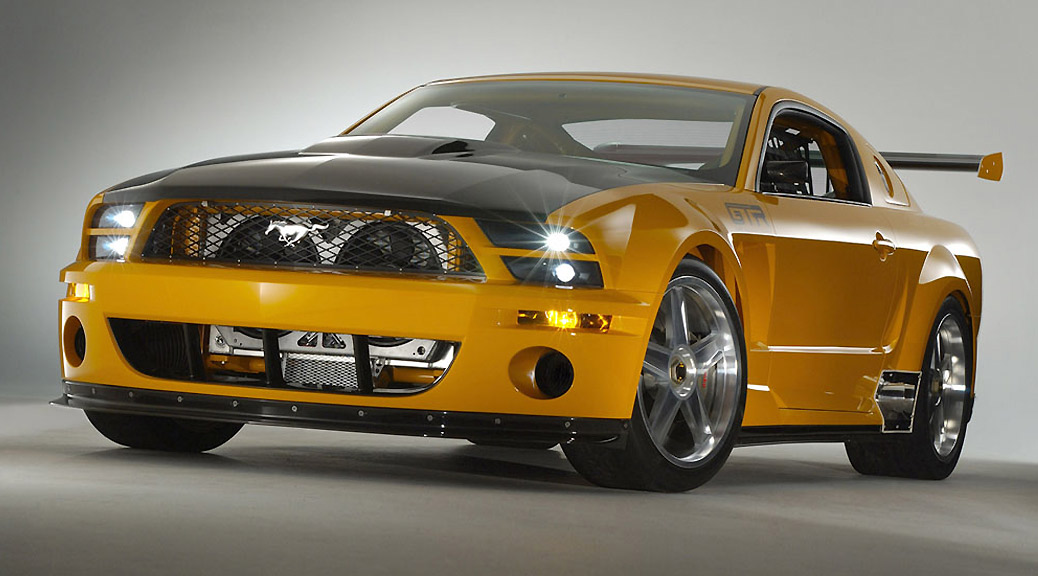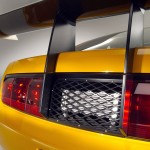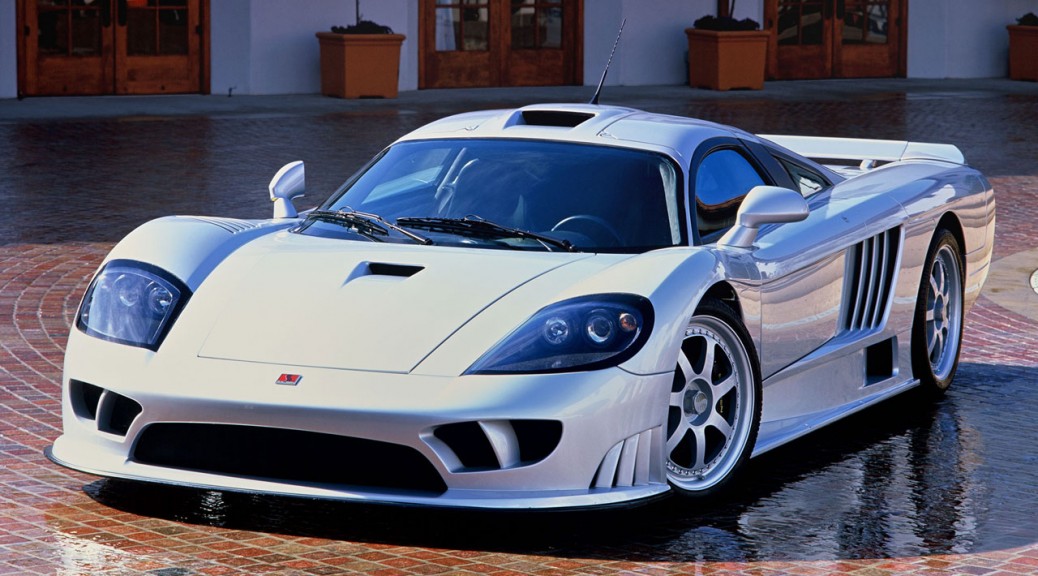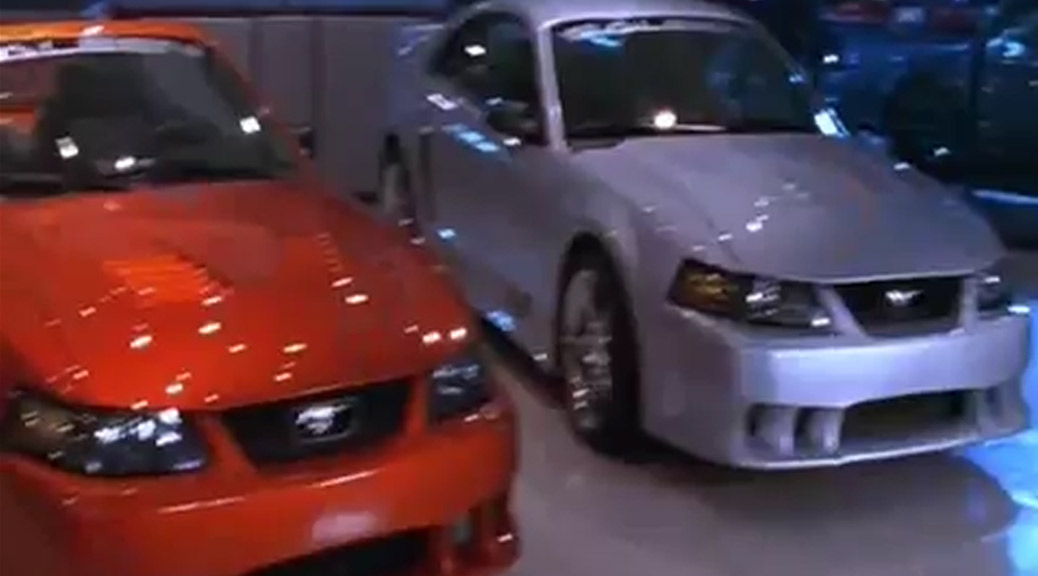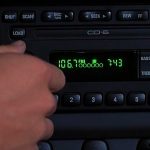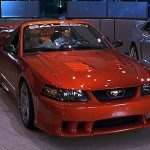By: LAWRENCE S. DIETZ on July 2003
Original Article: LOS ANGELES MAGAZINE, VOL. 48, ISSUE 7
Entrepreneur And Designer Steve Saleen
Has Made Irvine America’s Capital Of High-end Sports Cars
No one will mistake modern, master-planned Irvine for the ancient town of Maranello, Italy Nor will anyone confuse Orange County’s SUV-clogged stretch of the 405 freeway for the AI autostrada, prowled by the Ferraris that are Maranello’s most famous products.
Yet unassuming entrepreneur Steve Saleen has turned equally unassuming Irvine into Maranello West, the capital of high-end American sports cars. For nearly two decades he has rebuilt Ford Mustangs into hot performance vehicles. Three years ago his company launched the S7, which Road & Track has declared the fastest production car ever made. The 550-horsepower, carbon fiber-bodied speedster can hit 220 mph and go 0 to 60 in 3.3 seconds. And now Saleen Inc. is helping to manufacture a new version of Ford’s legendary GT40 race car, a vital part of the ailing giant’s recovery program.
At first glance the 53-year-old Saleen seems to be an unlikely architect of high rollers’ automotive dreams. About five feet seven, mustachioed, and balding, he looks like a middle-aged everyman, the sort of guy you’d expect to see selling insurance or riding around in a Camry.
Hardly Saleen is a USC business major turned race car driver who recognized a demand for very fast yet relatively affordable cars that were at home both on the track and on the street. Saleen’s vehicles have won titles for eight straight years and made their creator a hero among auto buffs–as well as a wealthy man. (Sales of the S7 have already hit $24 million.) Saleen Inc. also is making a splash on the big screen, its Mustangs appearing in summer releases including 2 Fast 2 Furious and Hollywood Homicide. (Saleen himself drives a Beryllium Saleen Extreme Speedster, the top of his Mustang line.)
As he sees it, the reason for his success is simple: “I have a tremendous passion for cars, for racing cars, and for driving.”
Saleen was first seduced by fast cars when his father, a manufacturing executive from Whittier, bought a Porsche while he was in college. After receiving his bachelor’s degree, Saleen started racing and was good enough to turn pro. He set 13 Sports Car Club of America records and finished third for the 1980 SCCA championship.
In the 1960s, racer Carroll Shelby had parlayed his track reputation into big money by modifying stock Mustangs. In 1984, Saleen started giving them better engines, suspensions, transmissions, and brakes, transforming cars that sell in the mid $20,000s into growlers that go for $36,000 to $70,000.
Saleen’s Mustangs outperform their rivals–the Porsche Boxster, Corvette hardtop, and SVT Mustang Cobra R–in terms of speed, lateral acceleration through turns, and braking. They carry a lower retail price, and just as important, they have a history of holding their resale value.
The cars quickly became winners on the SCCA circuit, capturing awards for driver, team, manufacturer, and tire in 1987. The Saleen Mustang has won the SCCA Manufacturer’s Championship six times, most recently in 2000.
During the late 1980s, Saleen moved his company into Indy car racing, hoping that victories at an event like the Indianapolis 500 would translate into a huge spike in his Mustang sales. “Looking back, it was the right thing to do at the wrong time,” he says. “From a marketing perspective, the concept was to expand our sphere of influence to new Saleen buyers. But we didn’t have the resources to race at that level, and a bad month of May [1989] in Indy killed us. The recession hit, and we had dealers going broke and not paying us for their cars. It was a lethal combination.”
His firm might have gone under if not for Tony Johnson, whose company owns many of the country’s largest (and most profitable) makers of original equipment for auto manufacturers. Johnson, president and CEO of Hidden Creek Industries in Minnesota, saw the marketplace value of Saleen’s brand identity.
“Steve is a great creative thinker, car person, and marketer,” says Johnson. “We needed to add just an additional touch of professionalism and business savvy” He gave Saleen financial backing (no one will say how much). Johnson, who became a partner and chairman of Saleen Inc., and Saleen, who retained the title of president, focused their efforts on the Mustang. When business picked up in i995, Saleen formed the Saleen/Allen “RRR” Speedlab racing team with Home Improvement star Time Allen.
Saleen now had the resources to realize a dream he’d harbored from the day he started manufacturing: He wanted to build and sell a supercar–a two-seat exotic that could cruise at 150 mph or more and win at the highest levels. In November 1999, he was ready to try. Johnson said yes. A year later the first S7 appeared.
Saleen managed to get from concept to finished vehicle so quickly because there was no bureaucracy no massive corporate infrastructure, no focus group. The only eyes that counted were his. Computers did most of the design work, an advance now used by most automotive manufacturers to shave months, even years, off development cycles and to trim costs. In the world of supercars, where a McLaren FI goes for a million dollars, the $395,000 S7 is something of a bargain.
The first seven S7s were snapped up by racing teams and outfitted for competition. An S7 won the 12 Hours of Sebring road race, and another placed a respectable third in class during June 2001’s rain- and crash-plagued 24 Hours of Le Mans. By that September S7s had competed in 25 races and won 17 of them, a stunning achievement for a newcomer.
Deposits were coming in from private buyers, including celebrities like Allen, Sylvester Stallone, and Jay Leno. By last December it was time to prove the S7’s advertised street readiness. The car passed its government tests, including a “coast down,” in which it was shifted into neutral at a speed of 120 mph and allowed to freewheel for a mile. How fast was it going after that? One hundred mph.
In the spring, Saleen produced three cars earmarked for press trials. The auto magazines were rapturous, starting with the design. “From every angle and from any distance, the Saleen S7 looks like a supercar,” wrote Joe DeMatio in Automobile. “Every pedestrian strolling along Santa Barbara’s State Street on a spring evening notices it. The gill-streaked body is very long, very wide, and very low… When the winglike doors are open, the S7 looks like something Martians would off-load from a spaceship.”
But the true measure of a car like the S7 is the driving. An hour spent behind the wheel of one is an extraordinary experience. The S7 is fast–I accelerated on an empty toll road and then “loafed” along at what I thought was an extremely comfortable 100, perhaps 110 mph. It felt as though the car could maintain that speed all day long. Then I looked more closely at the small speedometer; the needle was hovering over 140.
The S7 also can maneuver, hugging the road far better than anything most of us will ever drive. Move the wheel a tiny amount, and the S7 goes exactly where you want, no fuss. You find yourself smiling in pure pleasure.
The S7 gives Saleen Inc. a very profitable, if narrow, specialty. (With 62 sold, it has a planned production run of 300 to 400.) Working on the Ford GT, however, could offer the little company entree into the automotive big leagues.
The GT (it was nicknamed the GT40 because it was only 40 inches high) recalls Ford’s glory days in racing, as well as Henry Ford II’s hubris. In the early 1960s, he tried to get Enzo Ferrari to join him in developing a race car. When he was rebuffed by the patrician Italian, he decided to create his own. Once the GT’s engine and other specs were set, Carroll Shelby said, “Next year, Ferrari’s ass is mine.” And it was. Shelby raced and won in the GT40, as did Dan Gurney and A.J. Foyt.
These days Bill Ford Jr., Ford’s chairman, knows he needs a “halo-effect” car–one few in number but great in reputation–to help propel the company out of the misery caused by the Explorer/Firestone debacle in the late ’90s and quality problems typified by multiple recalls. The revived GT, which unlike its predecessor will be street legal, is supposed to be an icon of the new Ford Motor Company, crowning a rollout of ten models and vehicles in the Ford, Mercury, and Lincoln divisions in the next two years (and a total of 65 in the next five).
Saleen’s involvement with the GT started with a college connection. He had always kidded his public relations rep, Jack Gerken, about Gerken’s rabid partisanship for his alma mater, Notre Dame. In 2001, as it turned out, being a member of the Fighting Irish became as valuable in the car business as being a Harvard grad was in other corporate circles.
As part of a Ford management shakeup, several executives with Notre Dame ties came to power. Nick Scheele, the new group vice president in North America, was an alumnus whose son was attending the school, and Jim O’Connor, head of the Ford division, sat on the board of trustees.
Along with practically everyone else who did (or wanted to do) business with Ford, Saleen sought a way to meet Scheele. At the 2001 Pebble Beach Concours d’Elegance, the annual million-dollar antique car show where industry nabobs gather, Saleen joshed Gerken about playing the Notre Dame card with Scheele. Gerken took it seriously; especially since he had known Scheele since 1990, and his son and Scheele’s son were in the same dorm.
Introductions were made. Saleen, Gerken, and Tony Johnson later flew to Detroit to remind Scheele that Saleen Inc. was a good customer and to update him on the progress of the S7. They also had one crucial question: How can we be a better part of the Ford family?
The answer–Saleen should help build the GT–became clear at a meeting between Johnson and Scheele, held as Ford rushed to ready its prototype for introduction at the North American International Auto Show in Detroit in January, 2002.
After the car generated the intended buzz at the show, Ford went to builders and designers around the world, including Italy’s renowned Pininfarina. Saleen’s track record with the Mustang and the S7 earned it a spot as one of Ford’s four partners on the project. It will make the rolling chassis, frame, and suspension and will paint the body panels. The vehicles will be assembled at a Ford plant near Detroit, with major production scheduled to begin next year. The deal could cover as many as 5,000 cars. (Only 133 original GTs were built.)
“This is a process of producing a handful of cars each day;” says Neil Hannemann, Ford’s chief program engineer for the GT. “Ford didn’t want to learn how to do that, and Saleen does it.”
Besides providing such expertise, Saleen hopes to prove to the mainstream auto world that he can help to produce a special vehicle at a relatively reasonable price–according to industry, speculation, the GT will sell for about $125,000.
After all, Saleen already has the ultimate testimonial when it comes to his ability to fill a niche for a supreme power car. In the recent movie Bruce Almighty, he notes, God drives an S7.

